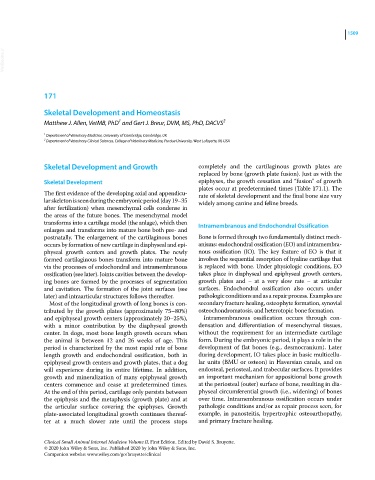Page 1571 - Clinical Small Animal Internal Medicine
P. 1571
1509
VetBooks.ir
171
Skeletal Development and Homeostasis
1
Matthew J. Allen, VetMB, PhD and Gert J. Breur, DVM, MS, PhD, DACVS 2
1 Department of Veterinary Medicine, University of Cambridge, Cambridge, UK
2 Department of Veterinary Clinical Sciences, College of Veterinary Medicine, Purdue University, West Lafayette, IN, USA
Skeletal Development and Growth completely and the cartilaginous growth plates are
replaced by bone (growth plate fusion). Just as with the
Skeletal Development epiphyses, the growth cessation and “fusion” of growth
plates occur at predetermined times (Table 171.1). The
The first evidence of the developing axial and appendicu- rate of skeletal development and the final bone size vary
lar skeleton is seen during the embryonic period (day 19–35 widely among canine and feline breeds.
after fertilization) when mesenchymal cells condense in
the areas of the future bones. The mesenchymal model
transforms into a cartilage model (the anlage), which then Intramembranous and Endochondral Ossification
enlarges and transforms into mature bone both pre‐ and
postnatally. The enlargement of the cartilaginous bones Bone is formed through two fundamentally distinct mech-
occurs by formation of new cartilage in diaphyseal and epi- anisms: endochondral ossification (EO) and intramembra-
physeal growth centers and growth plates. The newly nous ossification (IO). The key feature of EO is that it
formed cartilaginous bones transform into mature bone involves the sequential resorption of hyaline cartilage that
via the processes of endochondral and intramembranous is replaced with bone. Under physiologic conditions, EO
ossification (see later). Joints cavities between the develop- takes place in diaphyseal and epiphyseal growth centers,
ing bones are formed by the processes of segmentation growth plates and – at a very slow rate – at articular
and cavitation. The formation of the joint surfaces (see surfaces. Endochondral ossification also occurs under
later) and intraarticular structures follows thereafter. pathologic conditions and as a repair process. Examples are
Most of the longitudinal growth of long bones is con- secondary fracture healing, osteophyte formation, synovial
tributed by the growth plates (approximately 75–80%) osteochondromatosis, and heterotopic bone formation.
and epiphyseal growth centers (approximately 20–25%), Intramembranous ossification occurs through con-
with a minor contribution by the diaphyseal growth densation and differentiation of mesenchymal tissues,
center. In dogs, most bone length growth occurs when without the requirement for an intermediate cartilage
the animal is between 12 and 26 weeks of age. This form. During the embryonic period, it plays a role in the
period is characterized by the most rapid rate of bone development of flat bones (e.g., desmocranium). Later
length growth and endochondral ossification, both in during development, IO takes place in basic multicellu-
epiphyseal growth centers and growth plates, that a dog lar units (BMU or osteon) in Haversian canals, and on
will experience during its entire lifetime. In addition, endosteal, periosteal, and trabecular surfaces. It provides
growth and mineralization of many epiphyseal growth an important mechanism for appositional bone growth
centers commence and cease at predetermined times. at the periosteal (outer) surface of bone, resulting in dia-
At the end of this period, cartilage only persists between physeal circumferential growth (i.e., widening) of bones
the epiphysis and the metaphysis (growth plate) and at over time. Intramembranous ossification occurs under
the articular surface covering the epiphyses. Growth pathologic conditions and/or as repair process seen, for
plate‐associated longitudinal growth continues thereaf- example, in panosteitis, hypertrophic osteoarthopathy,
ter at a much slower rate until the process stops and primary fracture healing.
Clinical Small Animal Internal Medicine Volume II, First Edition. Edited by David S. Bruyette.
© 2020 John Wiley & Sons, Inc. Published 2020 by John Wiley & Sons, Inc.
Companion website: www.wiley.com/go/bruyette/clinical

